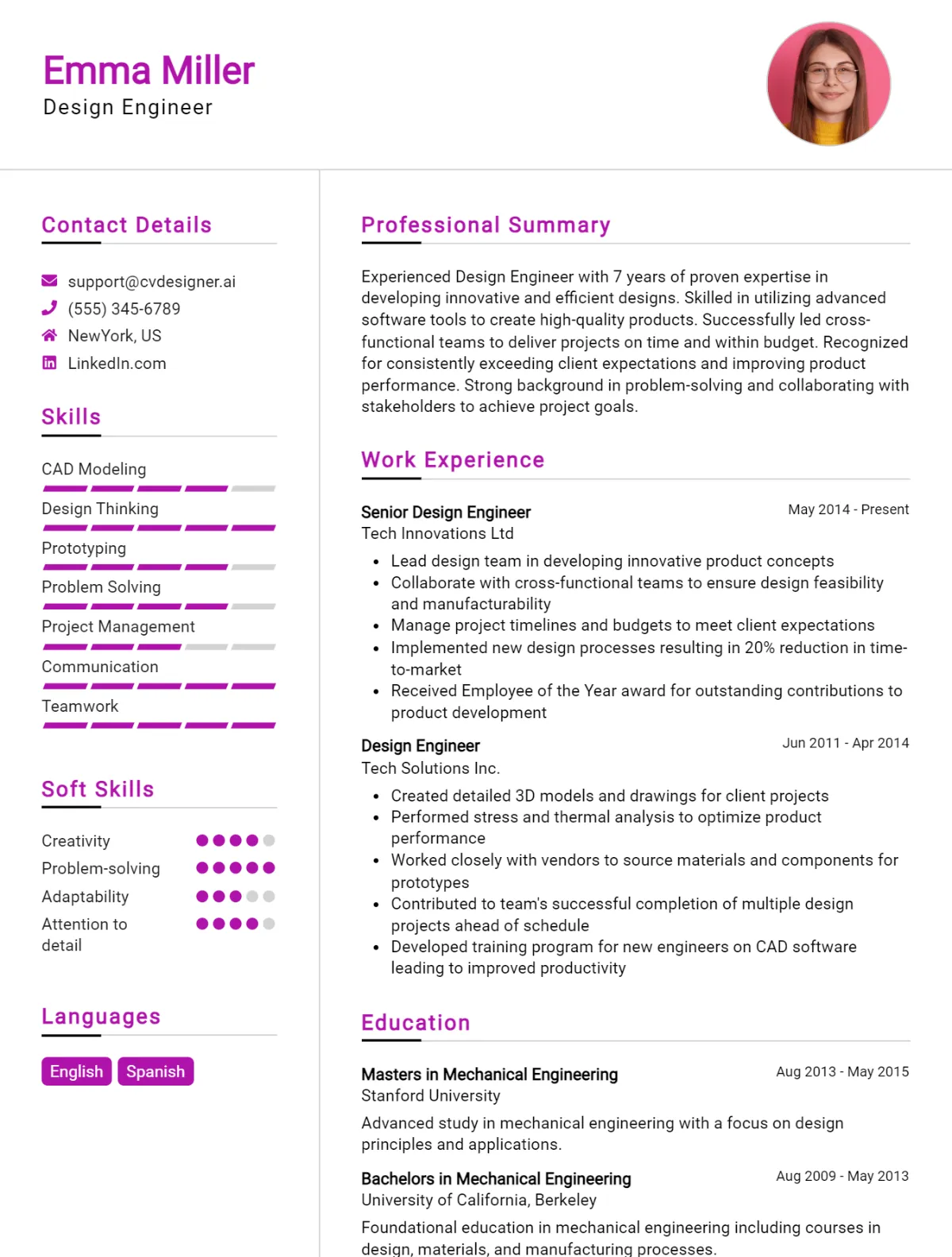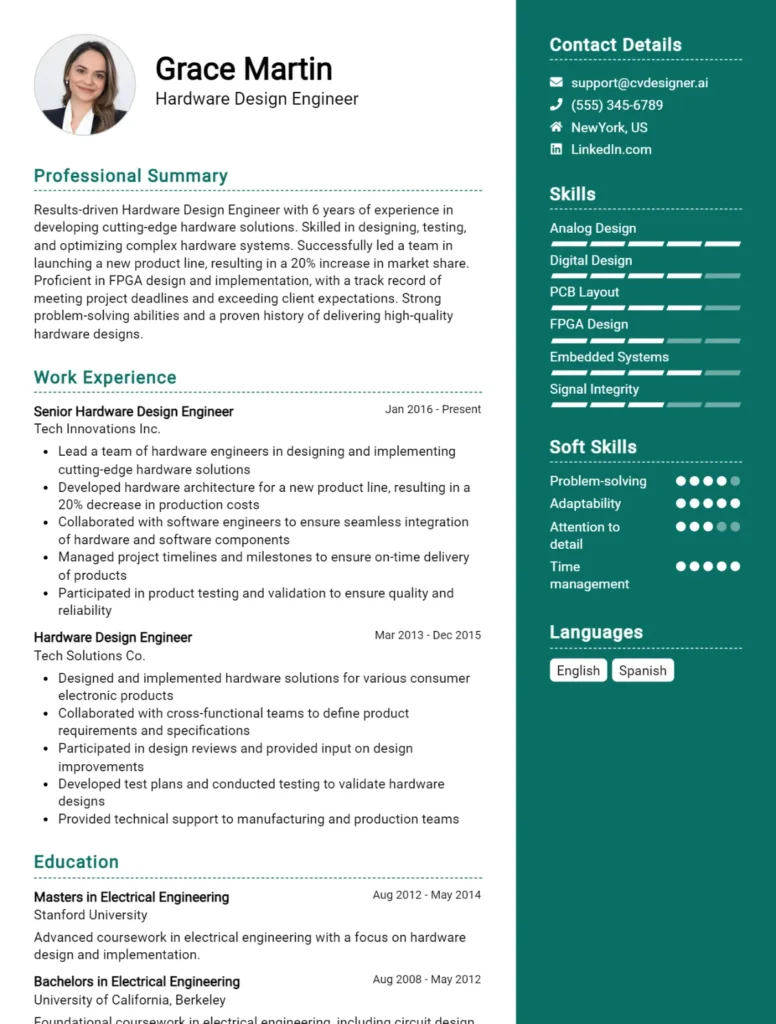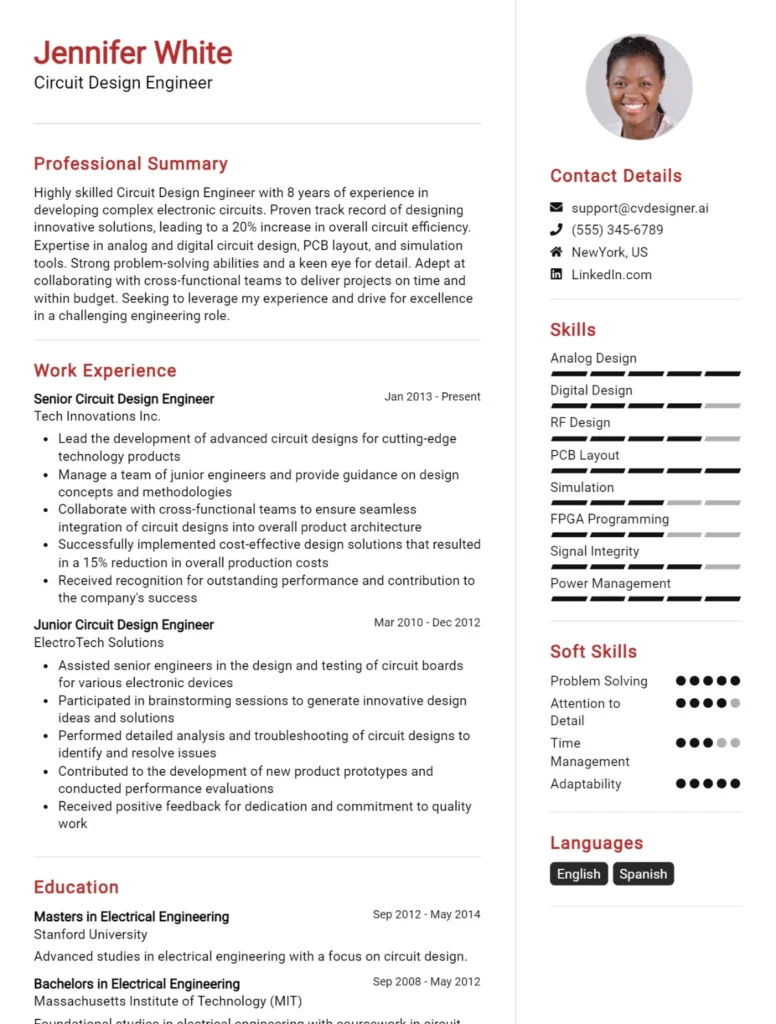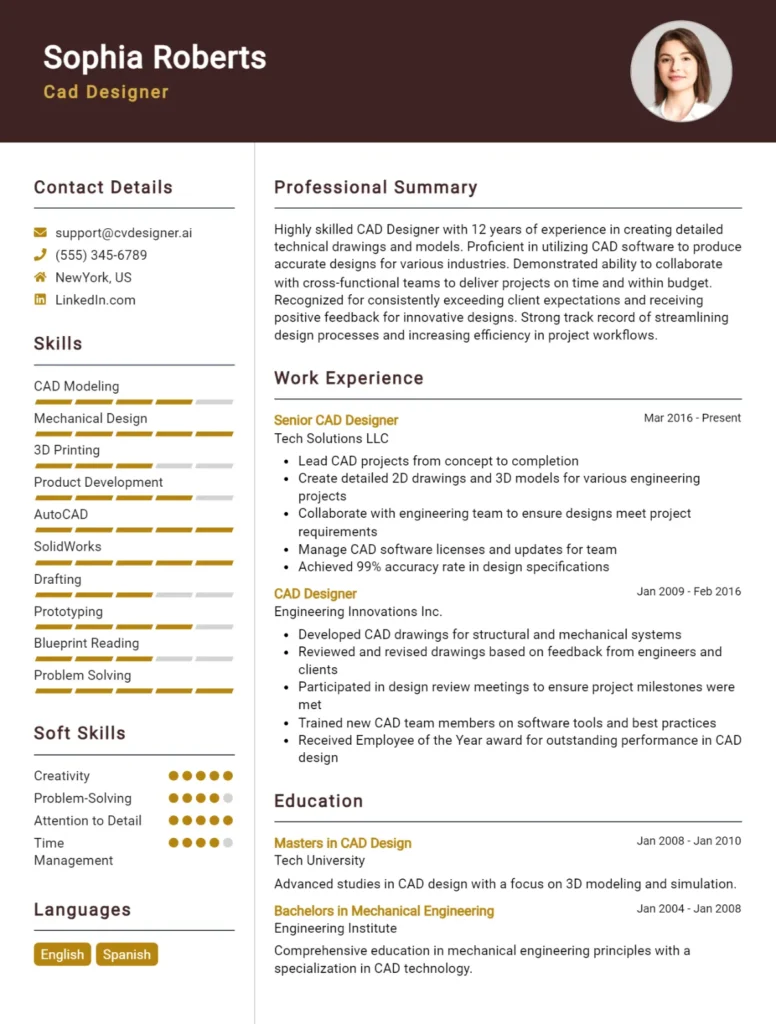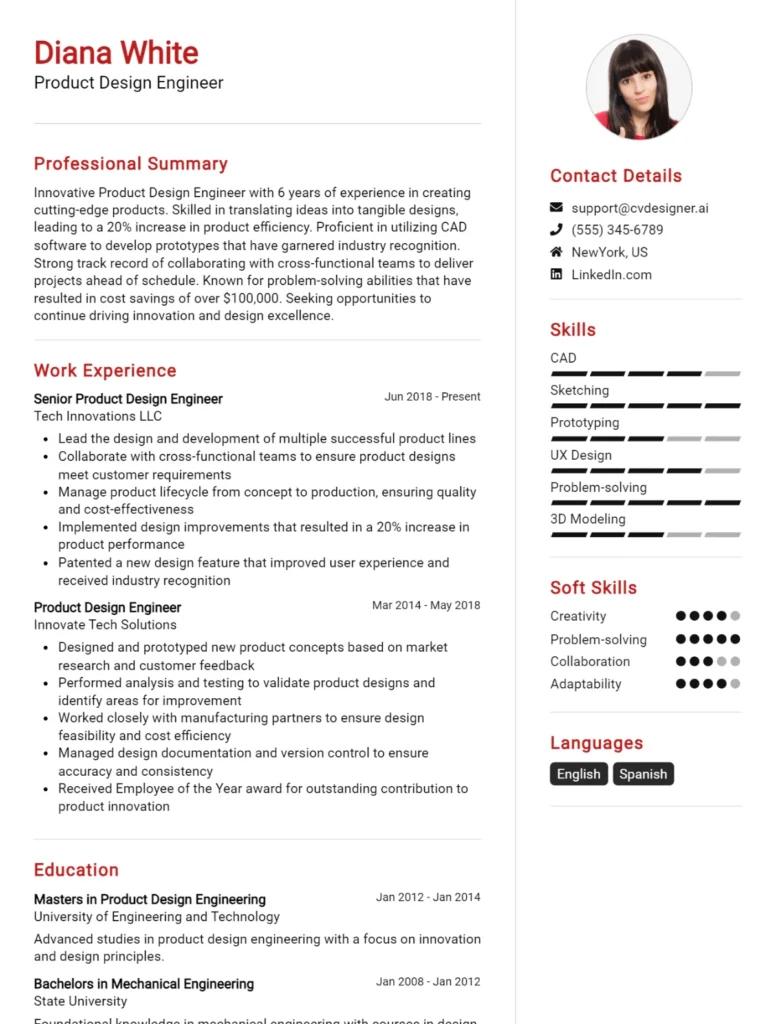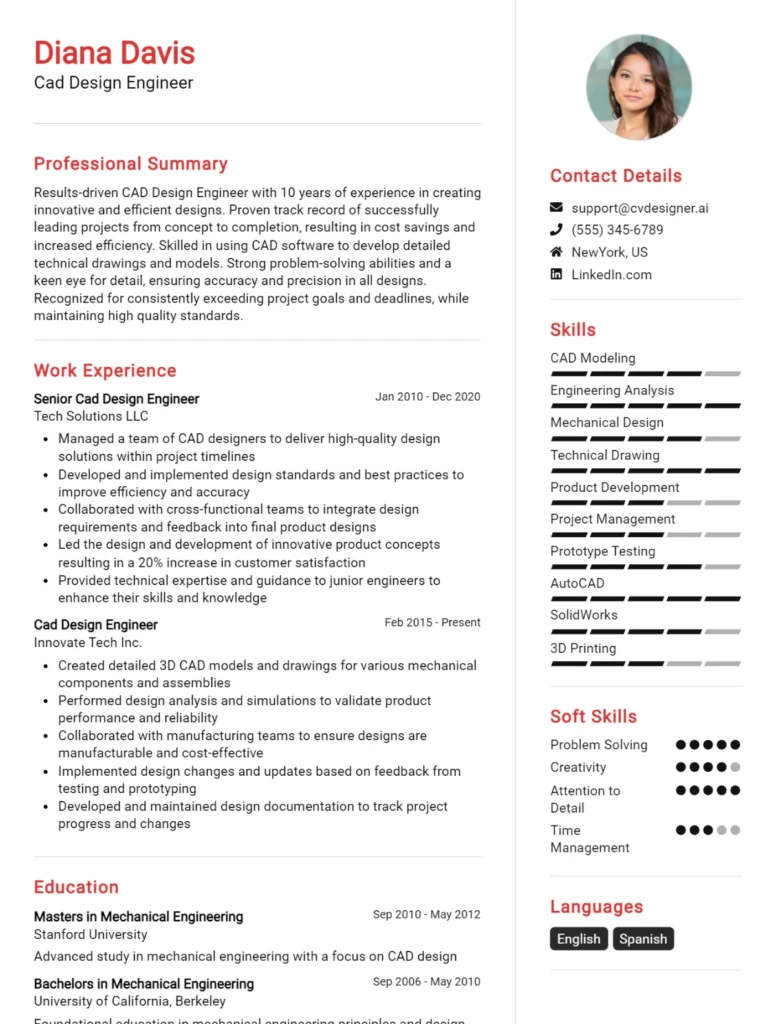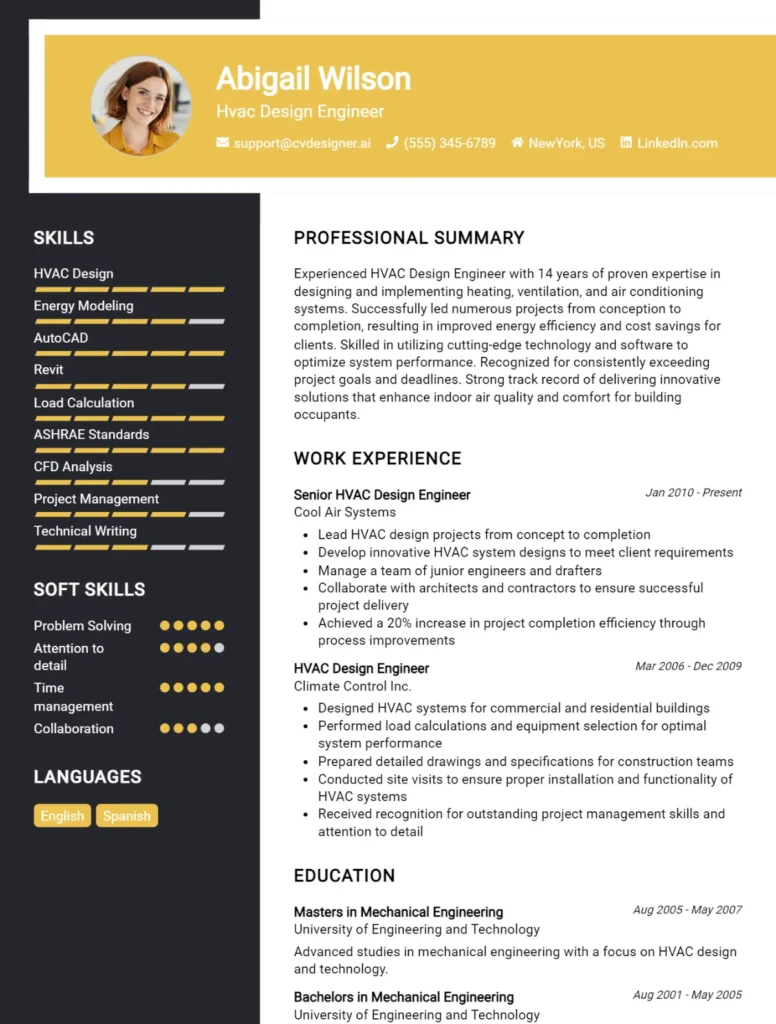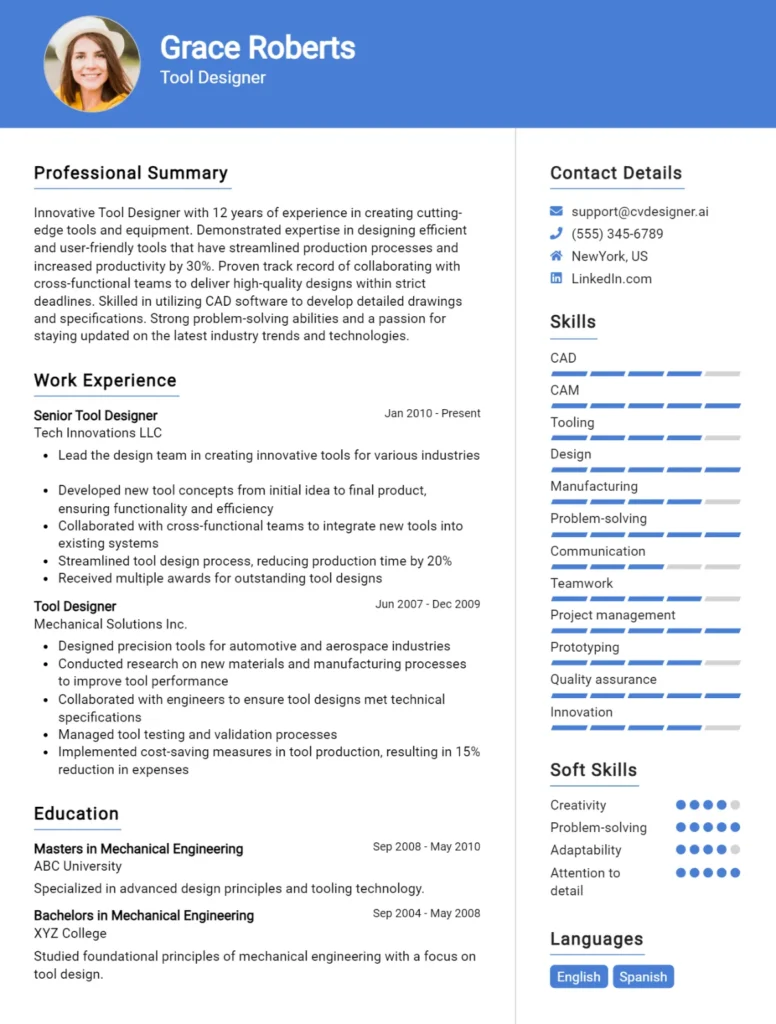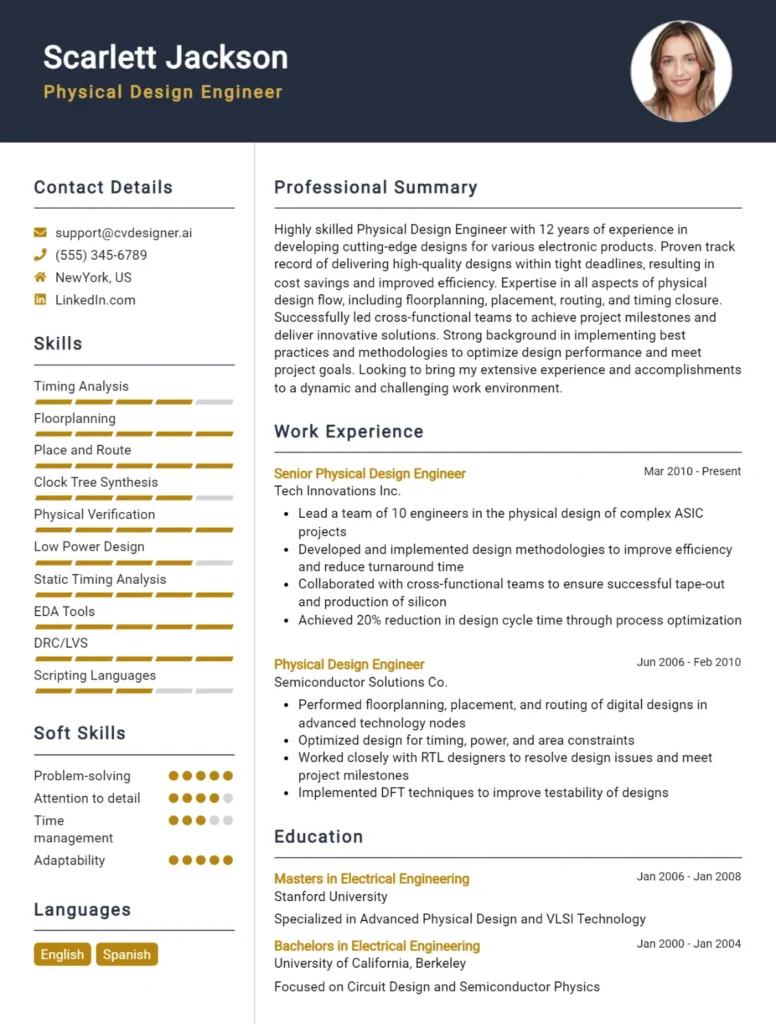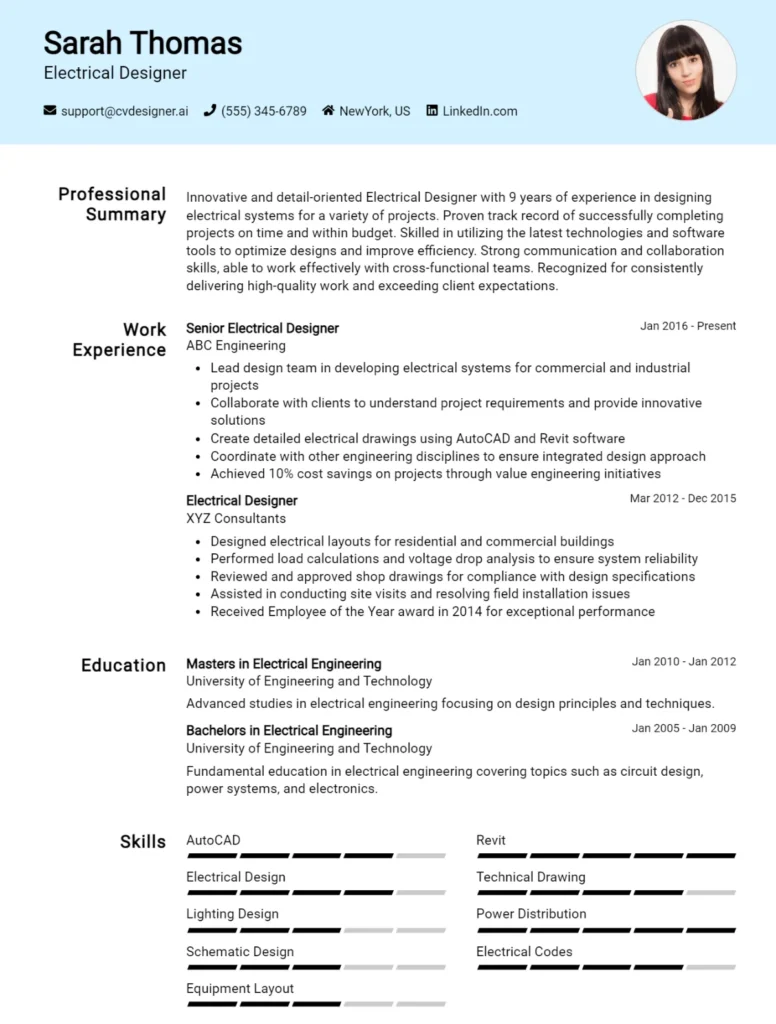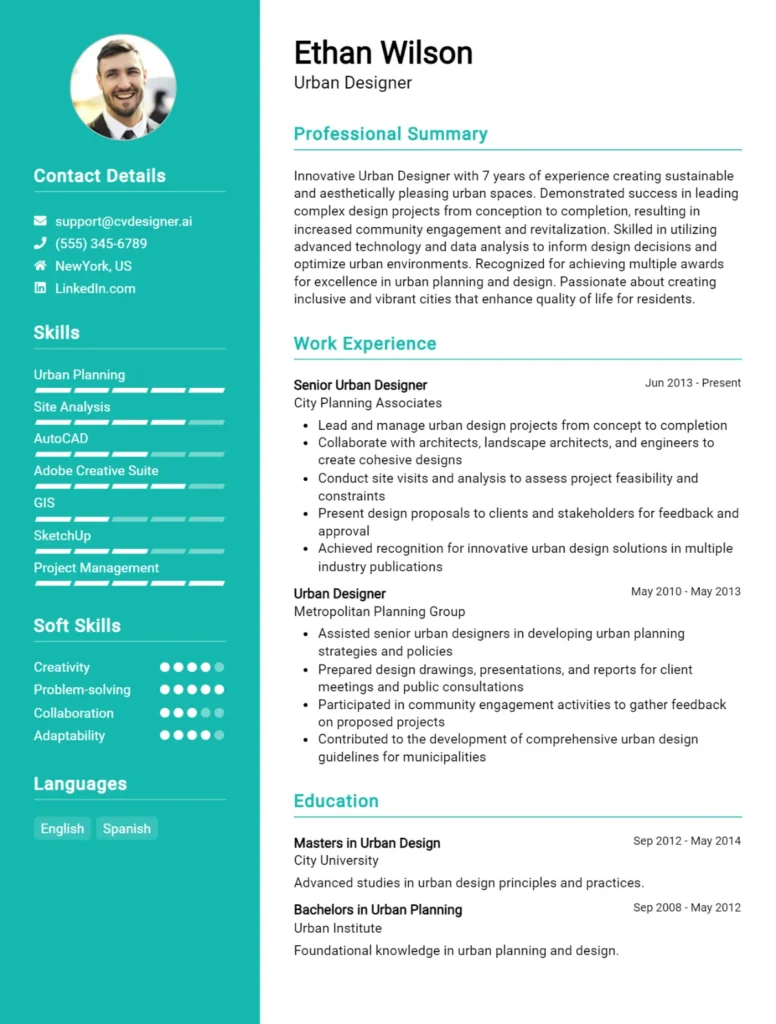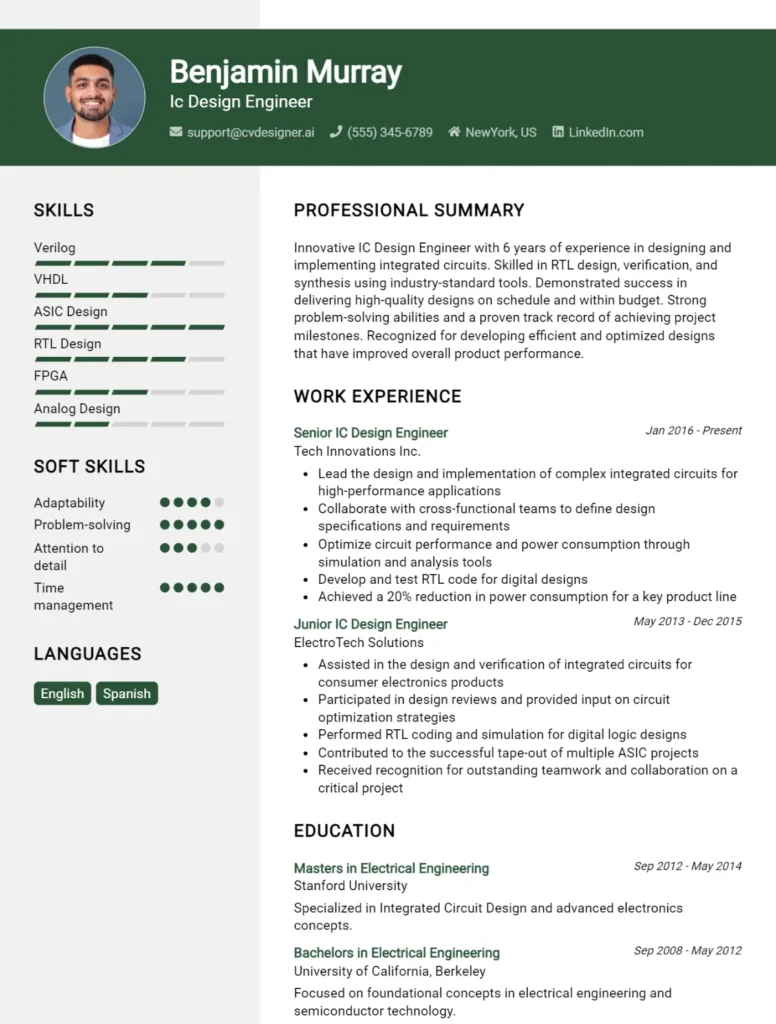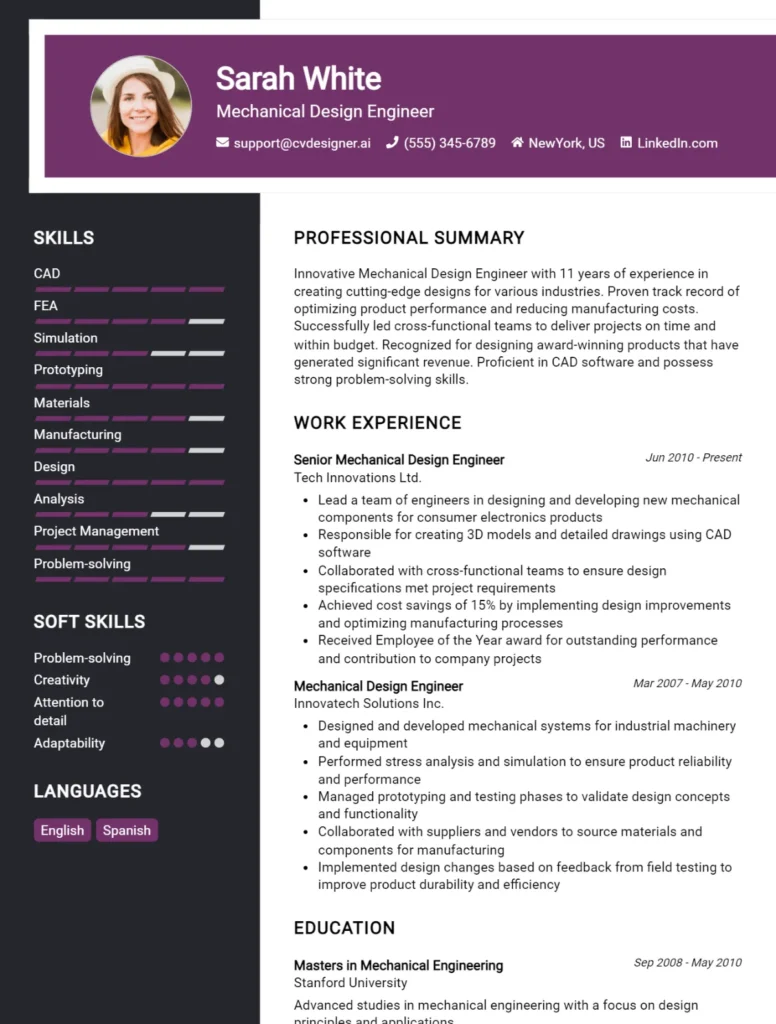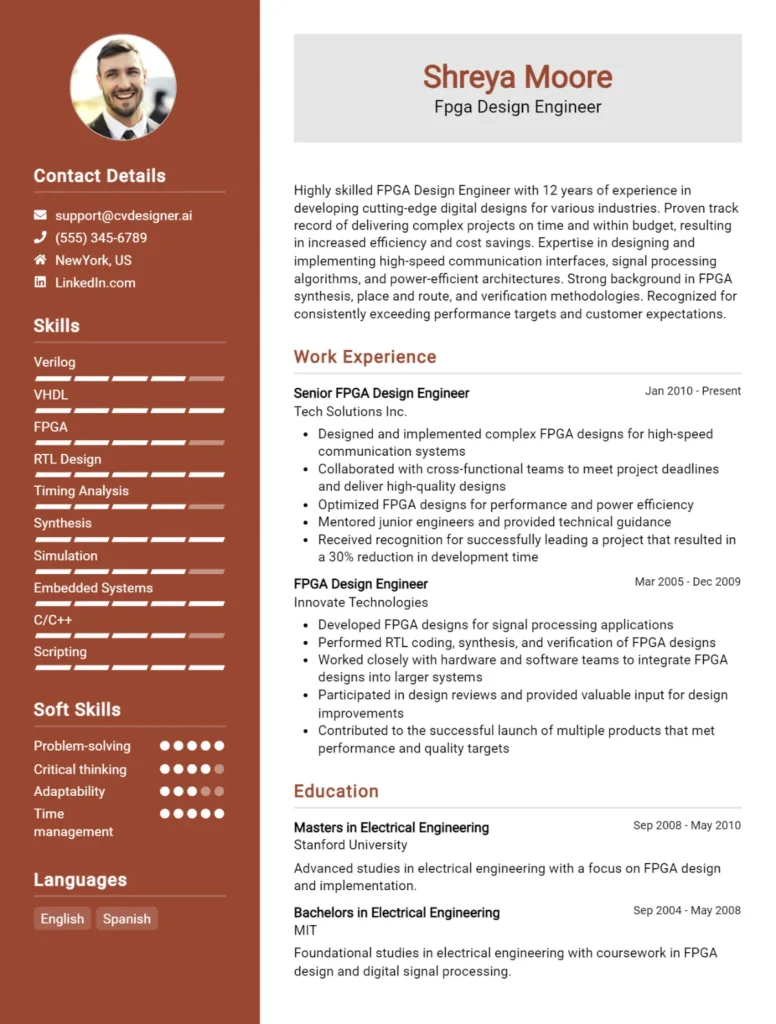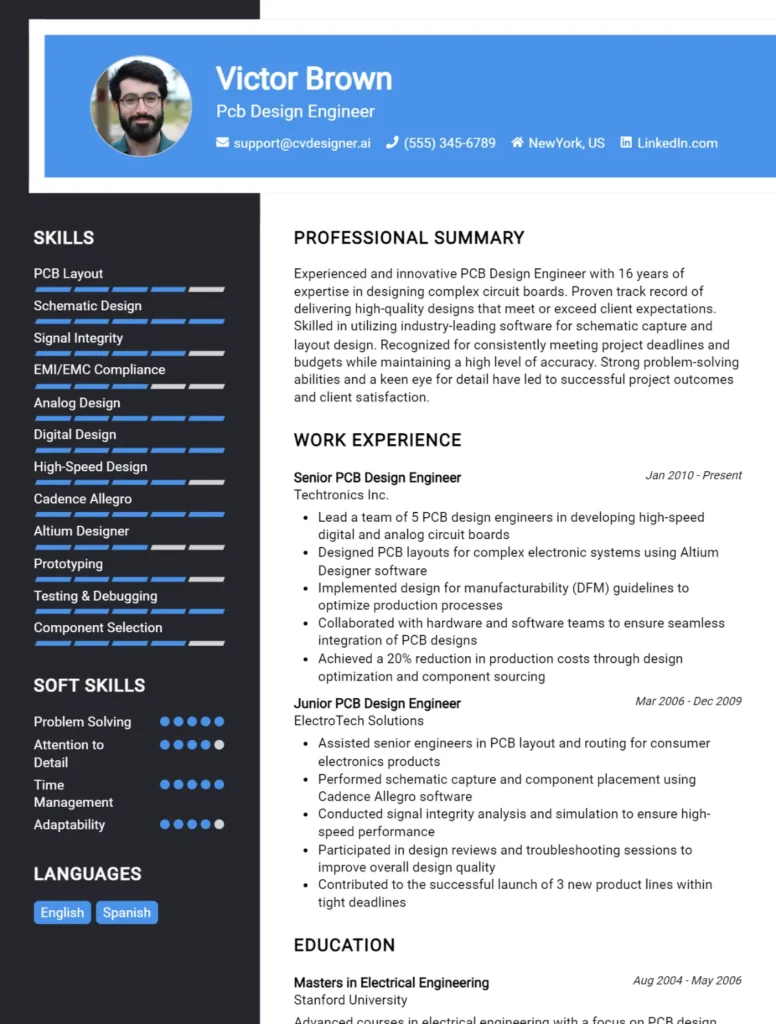Most Popular Design Engineer CV Examples
Explore additional Design Engineer CV samples and guides and see what works for your level of experience or role.
Are you ready to take the next step in your engineering career? Crafting an impeccable CV is crucial for standing out in a competitive job market, especially for a Design Engineer role. This guide will walk you through the essentials of writing a compelling CV that not only showcases your technical skills but also highlights your creativity and problem-solving abilities. From choosing the right format to tailoring your content for specific job applications, we’ve got you covered. Here’s what you can expect to learn:
- Understanding the Design Engineer Role: Insights into the skills and qualifications employers are looking for.
- CV Structure and Formatting: Best practices for organizing your CV to ensure clarity and professionalism.
- Personal Profile: How to craft a powerful summary that captures your unique strengths.
- Showcasing Technical Skills: Tips on effectively presenting your engineering skills and software proficiency.
- Highlighting Relevant Experience: Strategies for detailing your work history, projects, and achievements.
- Education and Certifications: What to include and how to present your academic background.
- Keywords and Tailoring: The importance of tailoring your CV for ATS (Applicant Tracking Systems) and specific job listings.
- CV Example: A real-world example of a successful Design Engineer CV to inspire your own.
Dive into this comprehensive guide to ensure your CV not only opens doors but also sets you on the path to your dream job in design engineering!
What is a Design Engineer CV?
A Design Engineer CV serves as a crucial tool for showcasing an individual's skills, experience, and qualifications in the engineering field. It highlights the candidate's technical expertise, creativity, and problem-solving abilities, which are essential for designing innovative products and systems. A well-crafted CV can effectively communicate the engineer's proficiency in software tools, project management, and collaboration within multidisciplinary teams. This document not only summarizes professional history but also reflects the candidate's understanding of design principles and their ability to translate concepts into practical applications.
The importance of a strong CV for a Design Engineer cannot be overstated, as it often serves as the first impression to potential employers. A compelling CV can help differentiate a candidate in a competitive job market, illustrating their unique contributions to previous projects and their potential impact on future endeavors. To create a standout CV, professionals can refer to a comprehensive cv writing guide that offers insights into formatting, key sections, and effective language. Additionally, utilizing a cv maker can streamline the process, allowing engineers to focus on showcasing their talents and experiences effectively.
Key Components of a Design Engineer CV
- Contact Information: Include your full name, phone number, email address, and LinkedIn profile to ensure potential employers can easily reach you.
- Professional Summary: A brief overview of your experience, key skills, and career objectives tailored to the design engineering field.
- Skills: Highlight relevant skills such as CAD software proficiency, materials knowledge, problem-solving abilities, and project management skills.
- Work Experience: Detail your relevant work experience, focusing on key projects, responsibilities, and achievements in previous design engineering roles.
- Education: List your degrees, relevant coursework, and certifications, including any specialized training related to design engineering.
- Projects: Showcase significant design projects you’ve worked on, including your role, the technologies used, and the outcomes achieved.
- Technical Proficiencies: Specify software and tools you are proficient in, such as AutoCAD, SolidWorks, or other engineering design software.
- Certifications: Include any professional certifications such as Certified SolidWorks Professional (CSWP) or Lean Six Sigma.
- Professional Affiliations: Mention memberships in relevant professional organizations like the American Society of Mechanical Engineers (ASME) or the Institute of Electrical and Electronics Engineers (IEEE).
- Publications and Patents: If applicable, list any publications or patents that you have authored or contributed to, showcasing your contribution to the field.
- Soft Skills: Highlight important soft skills such as teamwork, communication, adaptability, and leadership that are essential for collaboration in engineering projects.
- References: Provide references or state that they are available upon request, ensuring they can vouch for your skills and experience.
Sample Design Engineer CV for Inspiration
[Your Name]
[Your Address]
[City, State, Zip Code]
[Your Phone Number]
[Your Email Address]
[LinkedIn Profile URL]
Professional Summary
Dynamic and detail-oriented Design Engineer with over 5 years of experience in product design and development. Proficient in utilizing advanced CAD software and engineering principles to create innovative and user-friendly designs. Strong background in collaborating with cross-functional teams to bring concepts to life while ensuring adherence to industry standards. Adept at problem-solving and optimizing design processes to enhance efficiency and product quality.
Work Experience
Design Engineer
XYZ Engineering Solutions, City, State
March 2020 – Present
- Lead the design and development of mechanical components for consumer electronics, resulting in a 20% reduction in production costs.
- Collaborate with product managers and stakeholders to define project requirements and specifications, ensuring alignment with company goals.
- Utilize SolidWorks and AutoCAD to create 3D models and detailed drawings, performing regular design reviews and modifications based on feedback.
- Conduct simulations and stress analyses to validate designs, ensuring compliance with safety and performance standards.
- Mentor junior engineers and interns, providing guidance in design methodologies and best practices.
Junior Design Engineer
ABC Manufacturing, City, State
June 2018 – February 2020
- Assisted in the design and development of components for automotive applications, contributing to project timelines and deliverables.
- Created 2D and 3D design schematics using CATIA, facilitating communication with production teams and suppliers.
- Participated in prototype testing and evaluation, gathering data to inform design improvements and iterations.
- Documented design processes and maintained project records to ensure traceability and compliance.
Education
Bachelor of Science in Mechanical Engineering
University of Engineering, City, State
Graduated: May 2018
- Relevant Coursework: Advanced CAD, Materials Science, Thermodynamics, Fluid Mechanics
Skills
- Proficient in CAD software (SolidWorks, AutoCAD, CATIA)
- Strong knowledge of materials and manufacturing processes
- Excellent problem-solving and analytical skills
- Familiarity with FEA and CFD analysis tools
- Effective communication and teamwork abilities
- Project management and time management skills
Publications
- Smith, J., & Doe, J. (2022). "Innovative Design Approaches in Mechanical Engineering." Journal of Engineering Innovations, 15(3), 45-56.
- Smith, J. (2021). "The Role of CAD in Modern Product Development." International Conference on Engineering Design, Proceedings, 123-130.
Certifications
- Certified SolidWorks Professional (CSWP) – 2021
- Lean Six Sigma Green Belt – 2020
- AutoCAD Certified Professional – 2019
Design Engineer CV Writing Tips
When crafting a CV as a Design Engineer, it is essential to showcase your technical skills, creative problem-solving abilities, and relevant experience clearly and concisely. Focus on highlighting your proficiency in design software, project management, and collaboration with multidisciplinary teams. Tailor your CV to the specific job you’re applying for, ensuring that you present your achievements with quantifiable results where possible. Additionally, use a clean layout that enhances readability and draws attention to your most significant accomplishments.
CV Writing Tips for Design Engineers:
- Tailor Your CV: Customize your CV for each application by using keywords from the job description to match your skills and experiences.
- Highlight Technical Skills: List relevant software and tools you are proficient in, such as CAD programs, simulation software, and project management tools.
- Showcase Projects: Include detailed descriptions of key projects you’ve worked on, emphasizing your role, the challenges faced, and the results achieved.
- Quantify Achievements: Whenever possible, use numbers to illustrate your impact, such as cost savings, efficiency improvements, or project timelines.
- Include Certifications: Mention any relevant certifications or licenses that enhance your qualifications, such as Professional Engineer (PE) status or specific design software certifications.
- Emphasize Soft Skills: Don't overlook the importance of soft skills; highlight your teamwork, communication, and problem-solving capabilities.
- Use Clear Formatting: Ensure your CV is well-organized with clear headings and bullet points to enhance readability.
- Keep It Concise: Aim for a CV length of one to two pages, focusing only on the most relevant experiences and skills that pertain to the role.
Design Engineer CV Summary Examples
As a Design Engineer, crafting a compelling CV summary is crucial to effectively showcase your skills, experience, and passion for design. Here are several examples that can help you stand out in your job application:
Innovative Design Engineer with over 5 years of experience in creating efficient and sustainable designs in the automotive sector. Proficient in CAD software and a strong understanding of material properties, I am dedicated to delivering high-quality engineering solutions that exceed client expectations.
Detail-oriented Design Engineer with a proven track record of managing projects from concept through to completion. Adept in collaborative design processes and possessing strong analytical skills, I am passionate about leveraging technology to improve product functionality and user experience.
Dynamic Design Engineer specializing in mechanical systems with expertise in 3D modeling and prototyping. My ability to communicate effectively with cross-functional teams allows me to transform complex ideas into practical designs that align with corporate goals and client needs.
Results-driven Design Engineer with extensive experience in product development and design optimization. Skilled in using advanced simulation tools to refine designs and minimize production costs, I am committed to continuous improvement and innovation in engineering practices.
Creative Design Engineer with a background in electrical and electronic design, known for developing cutting-edge solutions that enhance product performance. My strong project management skills and attention to detail ensure that I deliver designs on time and within budget, driving project success.
Build a Strong Experience Section for Your Design Engineer CV
As a Design Engineer, showcasing your work experience effectively is crucial to demonstrate your technical skills, creativity, and ability to solve complex engineering problems. Here are some compelling examples of work experience descriptions that highlight key responsibilities and achievements in the design engineering field:
- Developed innovative product designs for a range of consumer electronics, leading to a 25% increase in customer satisfaction ratings and a lower production cost of 15% through efficient material selection and process optimization.
- Collaborated with cross-functional teams to create detailed 3D models and prototypes using CAD software, ensuring that all designs met industry standards and client specifications, which resulted in a 30% reduction in project timelines.
- Conducted rigorous testing and validation of prototypes to ensure compliance with safety regulations and performance benchmarks, successfully identifying and rectifying design flaws prior to mass production.
- Managed multiple design projects simultaneously, utilizing project management tools to track progress, budgets, and timelines, which improved project delivery rates by 40% over the previous year.
- Led design review sessions with stakeholders, presenting design concepts and receiving constructive feedback, which fostered collaborative improvements and increased stakeholder engagement throughout the project lifecycle.
- Utilized advanced simulation techniques to analyze stress and strain on components, optimizing designs for durability and performance, which contributed to a 20% decrease in product failure rates in the field.
- Spearheaded the introduction of sustainable design practices within the engineering team, resulting in a 10% reduction in waste during the manufacturing process and aligning with corporate sustainability objectives.
- Mentored junior engineers and interns, providing guidance on design principles and best practices, which enhanced team capabilities and fostered a culture of continuous learning within the engineering department.
Design Engineer CV Education Examples
As a Design Engineer, a solid educational background is crucial in developing the skills and knowledge necessary to excel in this field. Below are several examples of educational qualifications that are particularly relevant for aspiring Design Engineers:
- Bachelor of Science in Mechanical Engineering
This degree provides a comprehensive foundation in engineering principles, materials science, and thermodynamics, which are essential for designing mechanical systems and components. - Bachelor of Science in Industrial Design
Focusing on user-centered design, this program equips students with skills in product design, ergonomics, and visual communication, making it ideal for Design Engineers working on consumer products. - Master of Science in Aerospace Engineering
Advanced study in aerospace engineering prepares graduates for specialized roles in designing aircraft and spacecraft, emphasizing aerodynamics, propulsion systems, and structural analysis. - Bachelor of Science in Electrical Engineering
This degree offers a strong basis in electronics, circuit design, and control systems, vital for Design Engineers involved in developing electronic devices and systems. - Bachelor of Engineering in Civil Engineering
Providing essential knowledge in structural analysis, materials, and construction methods, this degree is suitable for Design Engineers focusing on infrastructure projects and construction design.
Skills to Highlight in Your Design Engineer CV
As a Design Engineer, showcasing a balance of both soft and hard skills in your CV is essential to demonstrate your capability to innovate and collaborate effectively in a fast-paced engineering environment. Below is a curated list of skills that highlight your technical expertise and interpersonal abilities, making you an ideal candidate for roles in design engineering.
Soft Skills:
- Problem-solving
- Communication
- Team collaboration
- Creativity
- Time management
- Adaptability
- Critical thinking
- Attention to detail
- Project management
- Conflict resolution
Hard Skills:
- CAD software proficiency (e.g., AutoCAD, SolidWorks)
- 3D modeling and simulation
- Engineering mathematics
- Materials science knowledge
- Prototyping techniques
- Design for manufacturability (DFM)
- Finite element analysis (FEA)
- Product lifecycle management (PLM)
- Knowledge of industry standards and regulations
- Electrical and mechanical systems understanding
Design Engineer CV Format
As a Design Engineer, having a well-structured CV is crucial for showcasing your technical skills, creativity, and project experience. The best format for your CV may vary depending on your level of experience—entry-level, mid-level, or senior-level roles. Choosing the right format can significantly enhance your chances of making a strong impression on potential employers.
- Entry-Level Design Engineer: Use a chronological format that highlights your education, internships, and relevant coursework. Focus on skills and projects that demonstrate your technical abilities.
- Mid-Level Design Engineer: Opt for a combination format that emphasizes both your work experience and technical skills. Include specific projects you’ve worked on, detailing your contributions and the impact you made.
- Senior-Level Design Engineer: A functional or hybrid format works best, showcasing leadership, strategic design decisions, and project management experience. Highlight your achievements and innovations in design processes.
- Visual Elements: Incorporate visuals such as charts or graphs to represent your accomplishments, especially if you have quantifiable results from your projects.
- Customization: Tailor your CV for each job application by including keywords from the job description. This will help to pass through applicant tracking systems (ATS).
- Professional Summary: Include a strong professional summary at the beginning of your CV that encapsulates your experience, skills, and what you bring to the role.
For more details on crafting the perfect CV, check out this cv format resource.
Common Mistakes to Avoid in a Design Engineer CV
When crafting a CV as a Design Engineer, it's essential to present your skills, experience, and achievements compellingly and professionally. A well-structured CV can significantly enhance your chances of landing an interview, while common pitfalls can detract from your qualifications and make you less appealing to potential employers. To help you create a standout CV, here are some common mistakes to avoid:
- Using a Generic Template: Employing a one-size-fits-all template can make your CV look unoriginal and fail to highlight your unique skills and experiences.
- Neglecting Tailoring: Failing to tailor your CV to the specific job description can result in missing key requirements that employers are looking for.
- Inadequate Technical Skills Section: Not clearly listing relevant design software and technical skills can lead to underrepresentation of your qualifications.
- Overloading with Jargon: Using excessive technical jargon may alienate non-technical recruiters who review your CV.
- Ignoring Achievements: Focusing solely on job duties rather than quantifiable achievements can make your contributions seem less impactful.
- Poor Formatting: A cluttered or inconsistent layout makes it difficult to read your CV and may turn off hiring managers.
- Lack of Specific Examples: Not providing concrete examples of projects you've worked on or problems you've solved can leave your skills and expertise unproven.
- Inconsistent Employment History: Gaps or inconsistencies in your employment history should be addressed clearly to avoid raising red flags.
- Failing to Proofread: Typos and grammatical errors can create a negative impression and suggest a lack of attention to detail.
- Omitting Contact Information: Forgetting to include your contact details or making them difficult to find can hinder potential employers from reaching out to you.
Key Takeaways for a Design Engineer CV
- Start with a strong professional summary that highlights your design engineering skills, relevant experience, and career objectives.
- Tailor your CV to the job description by emphasizing the most relevant skills and experiences that match the requirements of the position.
- Include a dedicated skills section, showcasing technical skills such as CAD software proficiency, materials knowledge, and project management abilities.
- List your professional experience in reverse chronological order, focusing on achievements and quantifiable results rather than just responsibilities.
- Highlight specific projects you've worked on, detailing your role, the technologies used, and the outcomes achieved.
- Incorporate keywords from the job posting to optimize your CV for applicant tracking systems (ATS).
- Include your educational background, specifying degrees, institutions, and any relevant certifications or training in design engineering.
- Add a section for professional affiliations, memberships, or any industry-related organizations you are part of.
- Consider using cv templates to create a visually appealing and structured layout.
- Use active language and action verbs to convey your contributions effectively.
- If applicable, mention any experience with cross-functional teams, showcasing your collaboration and communication skills.
- Finally, complement your CV with a tailored cover letter using cover letter templates that aligns with your CV and the job you're applying for.
Build your CV in minutes
Use an AI-powered cv builder and have your cv done in 5 minutes. Just select your template and our software will guide you through the process.
